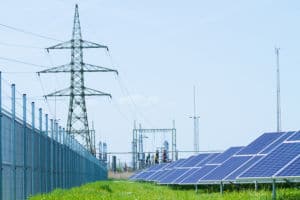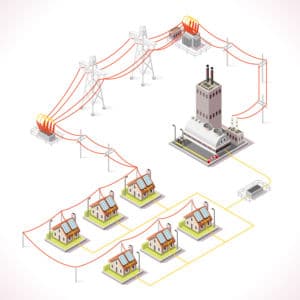 The North American electric grid is truly an impressive piece of infrastructure, connecting homes, businesses and other facilities to central energy sources. It has been described as the biggest machine on Earth. When part of the grid is damaged, however, such as during Super-Storm Sandy in 2012, entire blocks can lose power for weeks at a time. This can be devastating for facilities such as hospitals, medical centers, data centers or other businesses relying on constant uptime.
The North American electric grid is truly an impressive piece of infrastructure, connecting homes, businesses and other facilities to central energy sources. It has been described as the biggest machine on Earth. When part of the grid is damaged, however, such as during Super-Storm Sandy in 2012, entire blocks can lose power for weeks at a time. This can be devastating for facilities such as hospitals, medical centers, data centers or other businesses relying on constant uptime.
Local-scale power generation/consumption systems, known as microgrids, are becoming a popular alternative to typical grid reliance. As renewable energy has become cheaper and more reliable, these microgrids have become a more realistic and attractive prospect for many facilities and communities. With the ability to either operate independently or synchronously with the main power grid, rural areas or even urban facilities such as universities can use microgrids to ensure clean, reliable energy with optimal uptime.
What Is A Microgrid?
 The Department of Energy defines a microgrid as “A local energy grid with control capability, which means it can disconnect from the traditional grid and operate autonomously.”. While a typical microgrid will still pull most of its power from the larger electric grid, microgrid users can cut costs by lowering their total electricity consumption, especially during peak hours when electricity is more expensive and the grid is often overtaxed.
The Department of Energy defines a microgrid as “A local energy grid with control capability, which means it can disconnect from the traditional grid and operate autonomously.”. While a typical microgrid will still pull most of its power from the larger electric grid, microgrid users can cut costs by lowering their total electricity consumption, especially during peak hours when electricity is more expensive and the grid is often overtaxed.
While many conventional solar arrays do not provide power to its host facility in the event of a grid failure, in a microgrid setup, a transfer switch can separate the facility from the main grid either manually or automatically in order to function as a separate power producing island.
How Much Can a Microgrid power?
In an ideal setup, a microgrid should produce roughly the same amount of energy that the facility it is connected to consumes. This becomes important in the case of a blackout or other emergency, although a variety of setups exist. Some may not have the capacity to power everything in the case of a complete disconnect from the main grid, although this will largely depend on the amount and variety of power sources included in the microgrid.
Many microgrids are almost entirely powered by alternative energy sources such as solar, while others will also include conventional fossil fuel plants and/or battery systems that can provide energy during times when renewable sources are not available. Focusing on solar can make financing a microgrid project far more affordable, due to tax credits and other government funding programs available to renewable energy projects.
How Can SCF Help Establish a Microgrid?
SCF has a significant amount of experience working with non-conventional solar power projects, such as combined farmland arrays, community solar arrays and many more. Our experts can help you to determine the feasibility of such an array, as well as navigate the legal and technical issues in order to make it a reality.
For more information, please contact SCF today to discuss potential terms for your solar microgrid project.

